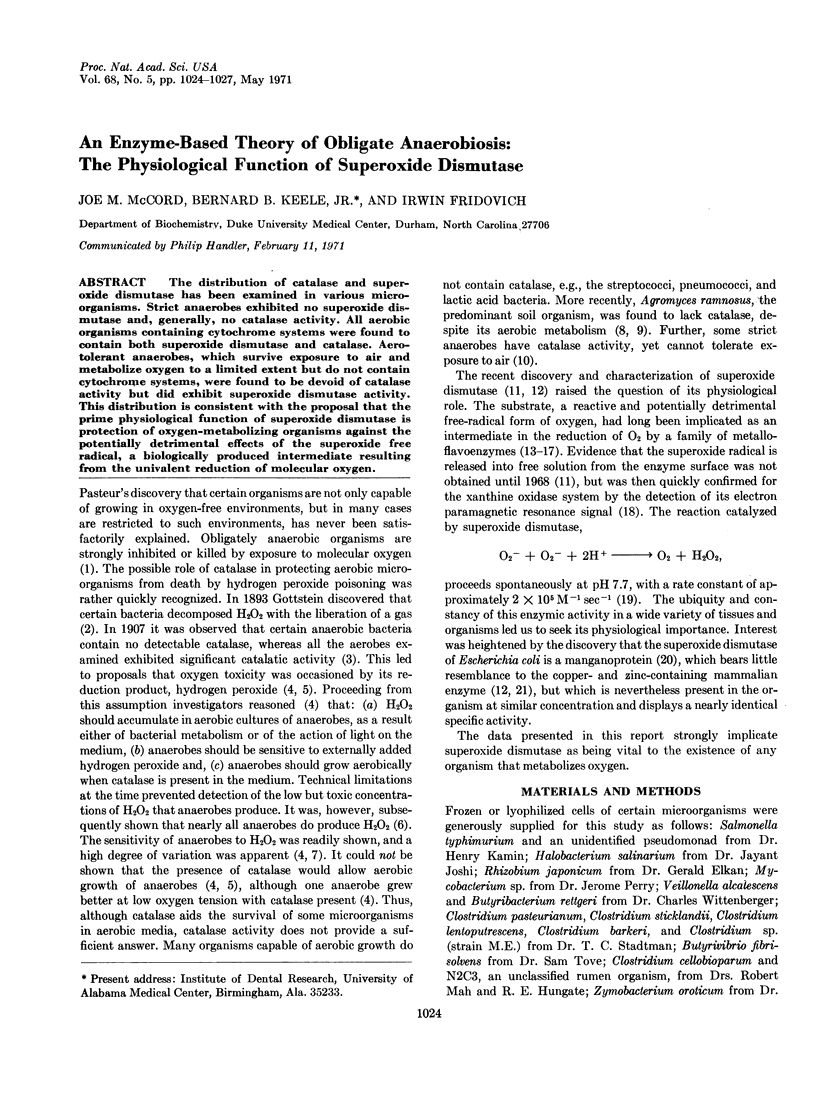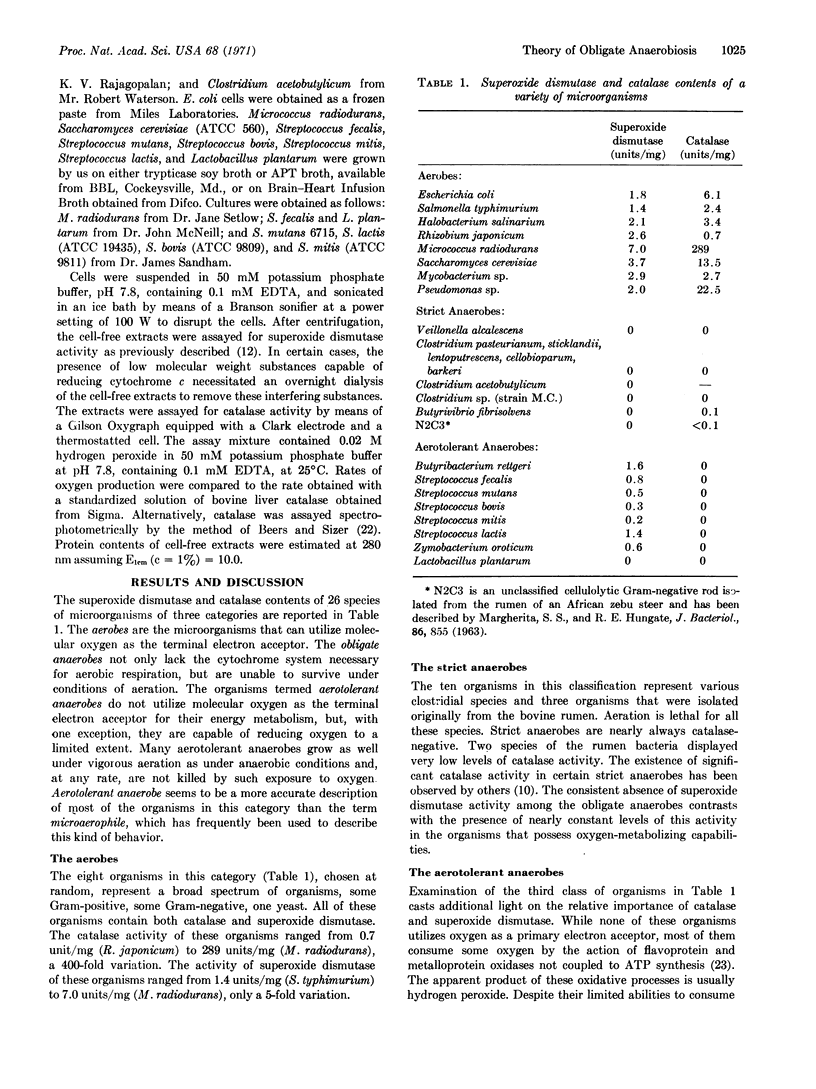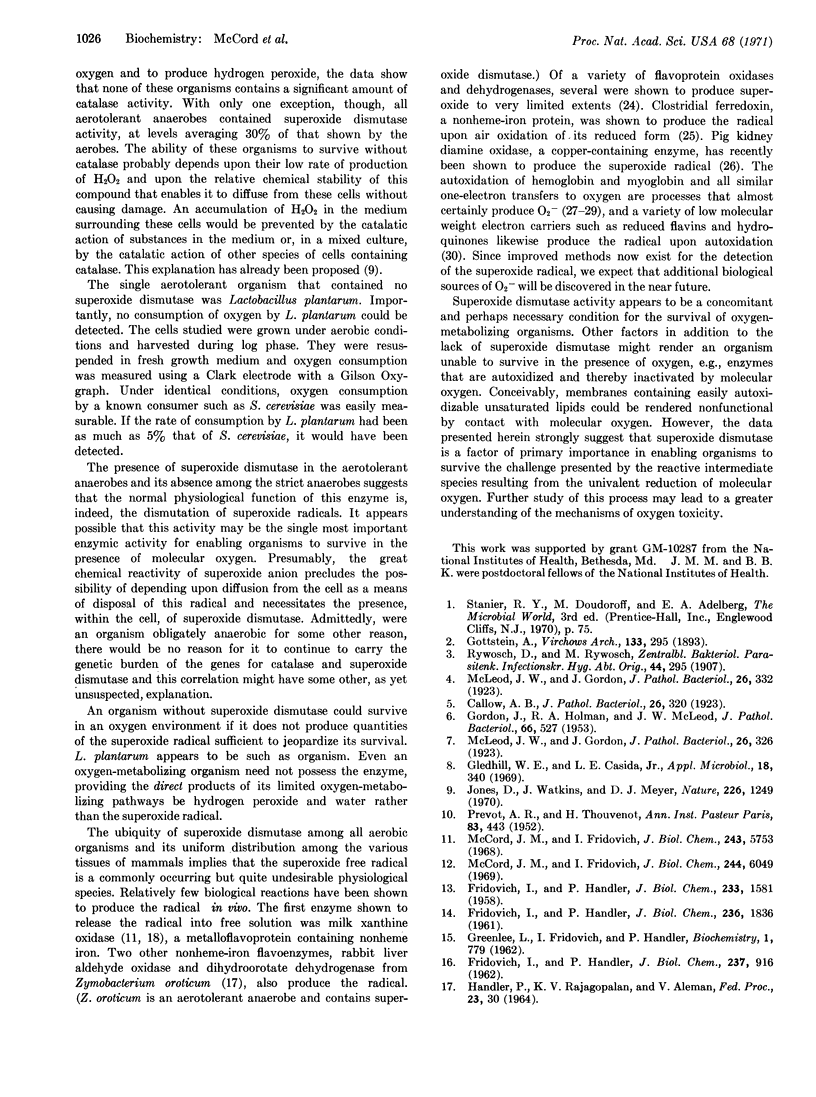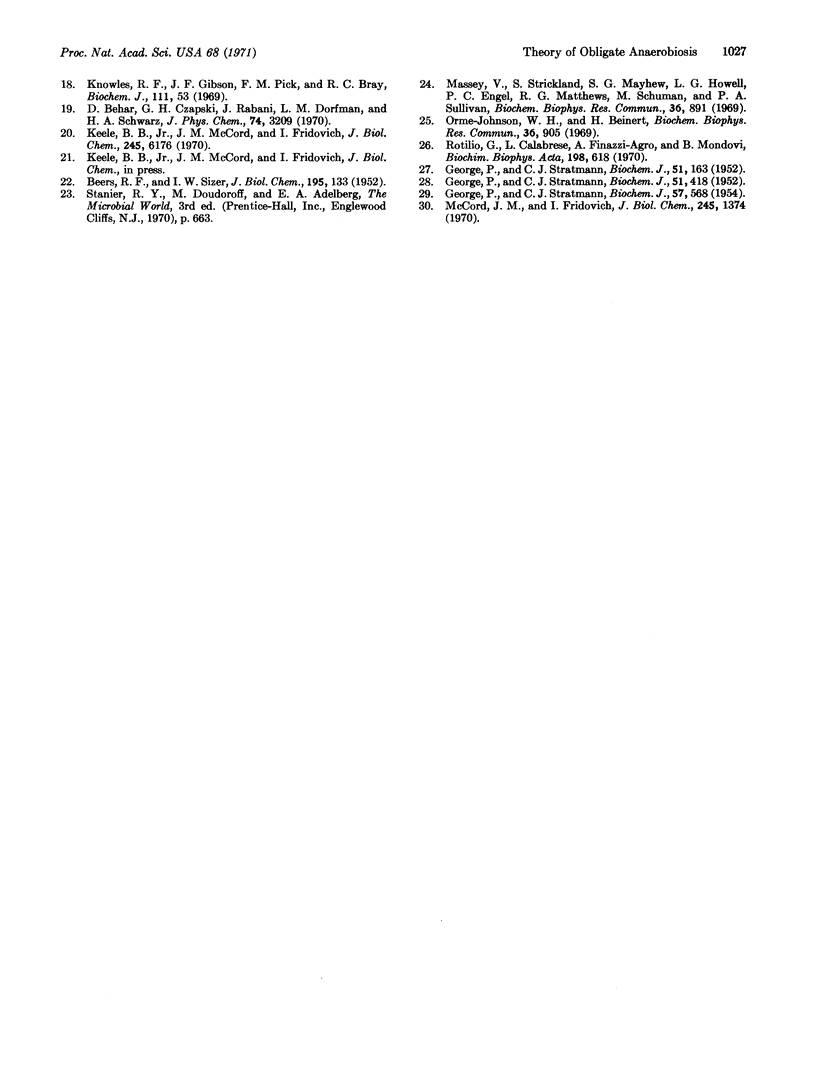Abstract
The distribution of catalase and superoxide dismutase has been examined in various micro-organisms. Strict anaerobes exhibited no superoxide dismutase and, generally, no catalase activity. All aerobic organisms containing cytochrome systems were found to contain both superoxide dismutase and catalase. Aerotolerant anaerobes, which survive exposure to air and metabolize oxygen to a limited extent but do not contain cytochrome systems, were found to be devoid of catalase activity but did exhibit superoxide dismutase activity. This distribution is consistent with the proposal that the prime physiological function of superoxide dismutase is protection of oxygen-metabolizing organisms against the potentially detrimental effects of the superoxide free radical, a biologically produced intermediate resulting from the univalent reduction of molecular oxygen.
Full text
PDF



Selected References
These references are in PubMed. This may not be the complete list of references from this article.
- BEERS R. F., Jr, SIZER I. W. A spectrophotometric method for measuring the breakdown of hydrogen peroxide by catalase. J Biol Chem. 1952 Mar;195(1):133–140. [PubMed] [Google Scholar]
- FRIDOVICH I., HANDLER P. Detection of free radicals generated during enzymic oxidations by the initiation of sulfite oxidation. J Biol Chem. 1961 Jun;236:1836–1840. [PubMed] [Google Scholar]
- FRIDOVICH I., HANDLER P. Xanthine oxidase. IV. Participation of iron in internal electron transport. J Biol Chem. 1958 Dec;233(6):1581–1585. [PubMed] [Google Scholar]
- FRIDOVICH I., HANDLER P. Xanthine oxidase. V. Differential inhibition of the reduction of various electron acceptors. J Biol Chem. 1962 Mar;237:916–921. [PubMed] [Google Scholar]
- GEORGE P., STRATMANN C. J. The oxidation of myoglobin to metmyglobin by oxygen. 2. The relation between the first order rate constant and the partial pressure of oxygen. Biochem J. 1952 Jun;51(3):418–425. doi: 10.1042/bj0510418. [DOI] [PMC free article] [PubMed] [Google Scholar]
- GEORGE P., STRATMANN C. J. The oxidation of myoglobin to metmyoglobin by oxygen. III. Kinetic studies in the presence of carbon monoxide, and at different hydrogen-ion concentrations with considerations regarding the stability of oxymyoglobin. Biochem J. 1954 Aug;57(4):568–573. doi: 10.1042/bj0570568. [DOI] [PMC free article] [PubMed] [Google Scholar]
- GORDON J., HOLMAN R. A., McLEOD J. W. Further observations on the production of hydrogen peroxide by anaerobic bacteria. J Pathol Bacteriol. 1953 Oct;66(2):527–537. doi: 10.1002/path.1700660224. [DOI] [PubMed] [Google Scholar]
- GREENLEE L., FRIDOVICH I., HANDLER P. Chemiluminescence induced by operation of iron-flavoproteins. Biochemistry. 1962 Sep;1:779–783. doi: 10.1021/bi00911a008. [DOI] [PubMed] [Google Scholar]
- Gledhill W. E., Casida L. E. Predominant Catalase-negative Soil Bacteria. III. Agromyces, gen. n., Microorganisms Intermediary to Actinomyces and Nocardia. Appl Microbiol. 1969 Sep;18(3):340–349. doi: 10.1128/am.18.3.340-349.1969. [DOI] [PMC free article] [PubMed] [Google Scholar]
- Jones D., Watkins J., Meyer D. J. Cytochrome composition and effect of catalase on growth of Agromyces ramnosus. Nature. 1970 Jun 27;226(5252):1249–1250. doi: 10.1038/2261249a0. [DOI] [PubMed] [Google Scholar]
- Keele B. B., Jr, McCord J. M., Fridovich I. Superoxide dismutase from escherichia coli B. A new manganese-containing enzyme. J Biol Chem. 1970 Nov 25;245(22):6176–6181. [PubMed] [Google Scholar]
- Knowles P. F., Gibson J. F., Pick F. M., Bray R. C. Electron-spin-resonance evidence for enzymic reduction of oxygen to a free radical, the superoxide ion. Biochem J. 1969 Jan;111(1):53–58. doi: 10.1042/bj1110053. [DOI] [PMC free article] [PubMed] [Google Scholar]
- Massey V., Strickland S., Mayhew S. G., Howell L. G., Engel P. C., Matthews R. G., Schuman M., Sullivan P. A. The production of superoxide anion radicals in the reaction of reduced flavins and flavoproteins with molecular oxygen. Biochem Biophys Res Commun. 1969 Sep 10;36(6):891–897. doi: 10.1016/0006-291x(69)90287-3. [DOI] [PubMed] [Google Scholar]
- McCord J. M., Fridovich I. Superoxide dismutase. An enzymic function for erythrocuprein (hemocuprein). J Biol Chem. 1969 Nov 25;244(22):6049–6055. [PubMed] [Google Scholar]
- McCord J. M., Fridovich I. The reduction of cytochrome c by milk xanthine oxidase. J Biol Chem. 1968 Nov 10;243(21):5753–5760. [PubMed] [Google Scholar]
- McCord J. M., Fridovich I. The utility of superoxide dismutase in studying free radical reactions. II. The mechanism of the mediation of cytochrome c reduction by a variety of electron carriers. J Biol Chem. 1970 Mar 25;245(6):1374–1377. [PubMed] [Google Scholar]
- Orme-Johnson W. H., Beinert H. On the formation of the superoxide anion radical during the reaction of reduced iron-sulfur proteins with oxygen. Biochem Biophys Res Commun. 1969 Sep 10;36(6):905–911. doi: 10.1016/0006-291x(69)90289-7. [DOI] [PubMed] [Google Scholar]
- PREVOT A. R., THOUVENOT H. Signification de la présence paradoxale d'une catalase chez certains anaérobies stricts. Ann Inst Pasteur (Paris) 1952 Oct;83(4):443–448. [PubMed] [Google Scholar]
- Rotilio G., Calabrese L., Finazzi Agrò A., Mondovì B. Indirect evidence for the production of superoxide anion radicals by pig kidney diamine oxidase. Biochim Biophys Acta. 1970 Mar 18;198(3):618–620. doi: 10.1016/0005-2744(70)90143-9. [DOI] [PubMed] [Google Scholar]


